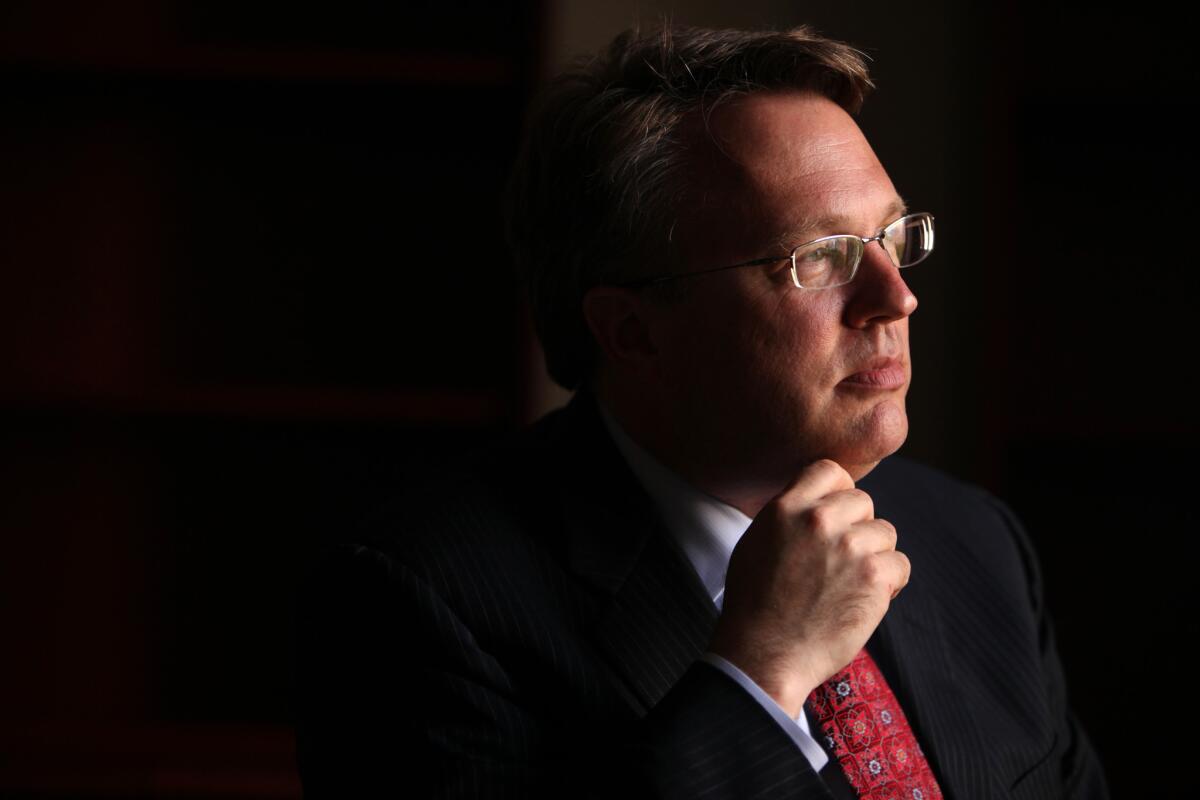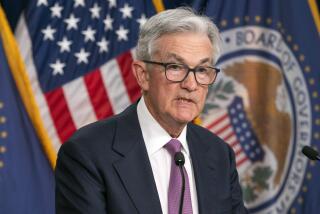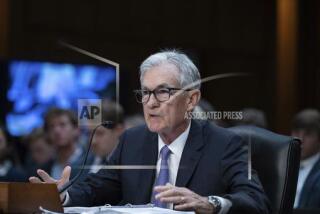Head of San Francisco Fed is still expecting modest economic growth, and more rate hikes

John C. Williams, president of the Federal Reserve Bank of San Francisco.
Reporting from Washington â For all the commotion in the world economy and almost daily paroxysms in financial markets, John C. Williamsâ outlook for U.S. growth and interest rate policy has barely budged.
The president of the Federal Reserve Bank of San Francisco remains as confident as he did a few months ago that American economic output will maintain the same middling, approximately 2.25% pace of growth this year that the nation has averaged over the past six years of recovery.
And unlike some of his colleagues at the Fed, who have suggested that the central bank hold off on raising interest rates next month, Williams says no such thing. The Fed lifted its benchmark rate in December after keeping it at near zero for seven years, but officials made no change at their last meeting in late January, amid tumbling stock and oil prices, and rising fears about Chinaâs slowdown.
Williams, in an interview with the Los Angeles Times, said the recent global developments certainly need to be closely monitored. But he said the âbig picture for me hasnât changed,â and his view on U.S. employment and inflation â the two key areas determining the Fedâs monetary policy â remains sanguine.
âThe basic approach we took, which is a gradual rate increase, is still right,â Williams said, while declining to predict whether he would support a rate hike at the Fedâs next meeting March 15-16. Williams isnât a voting member of the committee this year, as Fed district presidents serve on a rotating basis. But he participates in the meetings and weighs in on policy options.
The 53-year-old Stanford-trained economist is generally considered a centrist among top Fed officials. He is more optimistic, though, as far as the economy is concerned. Williams expects inflation to reach the Fedâs 2% target over the next two years. And he is particularly bullish on the employment picture, which he described with the words âgroovy timesâ in a speech to Town Hall Los Angeles on Thursday.
While Fed Chair Janet L. Yellen told lawmakers last week that she regarded the recent pickup in employee earnings as tentative, Williams said that all the signs pointed to an acceleration of wage growth. If anything, he noted, the earnings data seemed to be understating the increase as more recent job gains had come in lower-wage positions.
By one Labor Department measure, workersâ average hourly pay last month was up 2.5% from a year earlier. With the countryâs unemployment rate having fallen below 5% and job vacancies increasing, Williams said, âWeâre going to see further and further improvements in wages.â
Another indication that the labor market is just about back to normal, he said, is whatâs happened to the workforce participation rate over the last six months. For years many economists have rued the fact that millions of workers had essentially dropped out of the job market since the Great Recession, but Williams argued that the labor participation rate is now very close to the long-term trend of slower growth amid an aging population.
âI donât think thereâs a big puzzle there anymore,â he said.
Thatâs not to say American workers broadly are sharing in laborâs gains. Williams acknowledged that people in Californiaâs Central Valley, for example, where the unemployment rate remains in double digits, as well as other places across the country were still struggling with structural issues, such as low skills, which have made it harder for them to land jobs or boost incomes.
Income inequality, meanwhile, has continued to widen, he said, âaffecting peopleâs paychecks and feeding into peopleâs feeling and how [they] talk about the economy and [whether] we are really out of the recession or not.â
Risks of a U.S. recession have risen since the start of the year, and many private economists have ratcheted down their forecasts for economic growth this year, some predicting a rate of well below 2%. The Fedâs last forecast in December was for growth of 2.4%, but that is likely to be reduced at the March meeting.
Fed officials and most private economists have consistently been overly optimistic about economic growth in recent years. Williams explained that was almost entirely due to errors in assumptions about productivity growth.
In simplified terms, economic growth reflects the sum of changes in productivity and labor force or employment. âProductivity growth has been really abysmal over the last five years,â Williams said. âThe big question is, are we going to see a pickup in productivity growth or a continuation of sluggish productivity. If it is zero or really low, Iâm going to make the same forecast error as I made in the past,â he said.
While thereâs strong debate about productivity measurement, experts in the field think the weak productivity reflects the fading of the gains from the Internet and computer revolution, and the apparent absence of a new game-changing technology or breakthrough that is broadly transforming industries and peopleâs lives.
Williams himself is agnostic about whether the next big thing is on the horizon, but he doesnât see anything now that would sharply lift economic growth from current levels. While many analysts are hoping home-building and the housing market will finally kick into higher gear, Williams says some constraints remain -- the shift away from suburban single-family homes to apartments and condos in the city, and the lingering hesitancy on the part of builders to take greater risks.
Yet neither does Williams see any of the major wheels in the American economy coming off either. While many analysts and investors are worried about the magnitude of Chinaâs slowdown â and the potential spillover damage to the rest of the world â Williams seemed to be calling for cooler heads to prevail.
The world has known for some time that Chinaâs economy would be slowing as it transforms from exports and manufacturing investments to a service economy while also planning to liberalize its financial markets. âTo my mind, it doesnât seem like theyâve deviated a lot from the playbook theyâve laid out,â said Williams, who has made it a point to visit China fairly regularly. Turmoil in Chinese stocks and currency âcreates an outside appearance of uncertainty about what it is happening, but the bigger picture doesnât seem to have shifted much from a year or two ago.â
But should the global head winds stall or sharply slow U.S. growth, Williams argued that the Fed still had the wherewithal to respond, despite the thinking among many analysts that the central bank is largely out of ammunition. The Fedâs interest rate is less than 0.5%, so it could only lower it once before hitting rock bottom. Moving to a negative interest rate is something the Fed is studying, but Williams said it was far down the list of options. More likely, officials would follow with a new round of bond purchases to push down interest rates in a bid to spur investment and spending, even though many experts believe the Fedâs last purchase program did little good.
Williams disagreed. âJust looking at the playbook that we already used â and I think successfully used to add to growth â I think we can go back to that if needed,â he said. âThe fact that weâve just gone through all this in the last few years has better prepared us for the next recession.â
More to Read
Inside the business of entertainment
The Wide Shot brings you news, analysis and insights on everything from streaming wars to production â and what it all means for the future.
You may occasionally receive promotional content from the Los Angeles Times.











